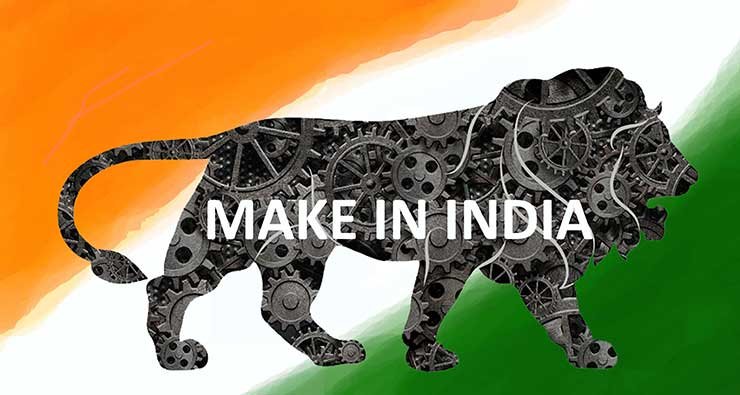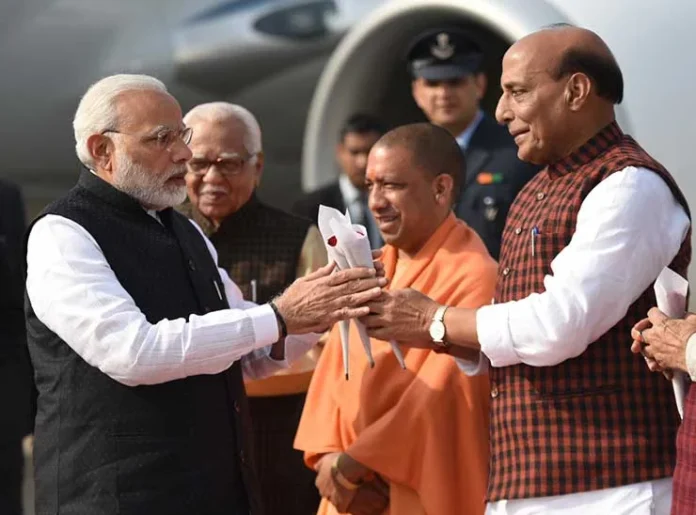New Delhi. In setting up a Defence Corridor in the biggest state of the country, the Modi government has opened up huge opportunities which if exploited intelligently and creatively could make Uttar Pradesh one of India’s leading states in terms of industrial production of the highest quality and caliber, and could also put the state on a path towards unparallelled economic growth.
Until recently, Uttar Pradesh was a frontier industrial state and therefore continues to have strong fundamentals with its ordinance factories, Public Sector Units, woollen and textile mills, wood, and many other private industries along with businesses. UP had the country’s top educational institutions producing graduates and post-graduates who were the cream of the crop of the Indian bureaucracy and the country’s scientific manpower. Unfortunately, the state could not keep pace with other states and has fallen back on multiple industrial parameters getting a negative tag of a ‘Bimaru’ state.
The Centre, by creating the UP-Defence Corridor (UPDC), has opened the floodgates for the state government to kickstart the creation of a world class manufacturing hub for the Indian and global aerospace and defence industry. If pursued with logical clarity, determination, a creative approach, it could help the state to achieve economic progress not witnessed in the recent past.
The state, reportedly, is in the process of announcing some incentives. If the UP Government was to take the following steps, then the state could prove to be a key mover and differentiator at a time when all states of the Indian Union are competing with each other for investments.
Since private enterprises are often not very comfortable working with government departments, the UPDC should not only be on earmarked government-owned land but should also cover entire cities in the identified areas. Private enterprise should be encouraged to establish industries without specifying areas.
In the past, the fine print in policies made it difficult for companies to access the incentives that encouraged them to establish set-ups in the state, a policy move borrowed from states such as Gujarat and Maharashtra. However, these states had consolidated their industrial development to a great degree prior to the introduction of these policies and therefore UP must be innovative in its defence policies in order to attract companies from these states.

Facilitation of offsets is very vague, therefore direct financial incentives from the state government would be a better idea. By asking offset multipliers for offset executing private enterprise from the central government, new companies in the vendor base of international companies could be brought to UP.
The state has multiple Aerospace and Defence (A&D) companies such as HAL, many Ordinance factories, BEL, etc. that have an eco-system of vendors and suppliers across the country. These companies should be incentivised to source their goods and materials locally. These incentives can occur in the form of input subsidies (electricity or land registration) along with direct cash benefit which these companies can use for their own capital growth or expansion. This will help complete supply chain growth from the original equipment manufacturer (OEM) to multi-tiered suppliers as the OEM can pass on the cost benefit to potential customers, thereby making them more competitive while also helping to develop an alternate supply chain of MSME vendors in the state. Another geographical incentive could be provided to offset multipliers by getting sourcing done by global companies (OEMs and their Tier suppliers) from the UPDC. It can be done through the Defence Ministry to provide for the offset multiplier incentive in their regulatory guidelines document (Defence Procurement Procedure – DPP) in their next revision.
A&D industry is at the forefront of technological innovation and thus require specialized development of the human resources and skill sets that is unique to the sector and is not particularly fungible from other manufacturing segments. Building the requisite skill sets for people to make them employable in the Aerospace industry requires extensive training and exposure to the highest global standards and puts heavy burdens on companies especially, MSMEs.
Since the cost of skills development cannot be directly transferred to customers, the Government may consider establishing skill centers of excellence in identified key areas where the relevant bench strength in India is at low levels. The state may also invest in the training costs of UP domiciled individuals with a view to develop their skill sets for work within the state’s aerospace industry.
A key aspect of the A&D manufacturing industry is the stringent quality certification and testing requirements. These are crucial throughout the production process with each component undergoing a specific number of tests and certification processes that are undertaken by either specialist QC laboratories or executed in-house facility by making heavy investments. The recruitment, training, and maintenance of qualified personnel involves heavy costs, but availability is also a challenge, since the prevailing A&D clusters are in Bangalore or Hyderabad. The government may like to encourage the establishment of labs in technical educational institutes (IITs, etc) or fund the construction of laboratories in the private sector. This infrastructure can be made accessible to other companies at a nominal fee which in turn would make the rest of the industries competitive in the national and international markets, and thus bring greater revenues to the state.
Even though India has made great strides in the A&D sector, most of the specialist military grade raw material for manufacturing these products is still imported. This requires companies to plan and manage stocks with very high logistics and inventory costs. Maintaining large inventories is cost intensive and also blocks capital. The government may explore subsidising cost of materials or cover the cost of transporting these into the UPDC. Alternatively, the government may explore establishing import-export warehouses from which MSMEs can procure these materials on an ‘as required’ basis towards better utilization of their working capital.
Further, the Government could create logistics centers that would serve as single window domestic delivery support centers with their own fleet of vehicles. Multiple companies within the corridor can take advantage of this benefit through the sharing of space within the transport fleet, both for incoming materials and the outgoing of finished components and products. It also eases the management cost of logistics which are under the preview of the owner/management in most MSMEs.
Given UP’s potential as a hub for A&D manufacturing and industry, the creation of a defence corridor as introduced by the central government could be the catalyst towards an unprecedented level of economic development. Incentives allowing for industries to thrive in the state and create thousands of jobs for its population would attract not only investment but also human capital into UP, propelling it towards a new era as a powerhouse of consolidated industrial strength.





